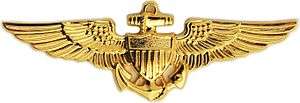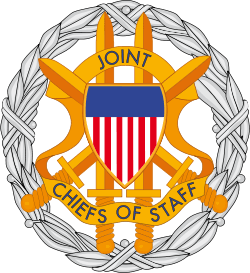Thomas B. Hayward
| Thomas B. Hayward | |
|---|---|
 Admiral Thomas B. Hayward, 21st Chief of Naval Operations | |
| Born |
May 3, 1924 Glendale, California |
| Allegiance | United States of America |
| Service/branch | United States Navy |
| Years of service | 1948–1982 |
| Rank |
|
| Commands held | Chief of Naval Operations |
| Awards |
Defense Distinguished Service Medal (2) Navy Distinguished Service Medal (3) Coast Guard Distinguished Service Medal Legion of Merit (3) with Combat V Distinguished Flying Cross |
Admiral Thomas Bibb Hayward (born May 3, 1924) was Chief of Naval Operations (CNO) for the United States Navy from July 1, 1978, until June 30, 1982,[1] after which he retired from military service. Shortly after the commencement of World War II, he enlisted in the U.S. Navy V-5 aviation program and was called to active duty as a naval aviation cadet in 1943, anticipating that he would shortly be flying combat in the South Pacific. However, when roughly half way through the flight training syllabus, he competed for and was accepted to attend the U.S. Naval Academy at Annapolis, Maryland, to position himself for a career in the U.S. Navy at war's end. He graduated from the Academy in July, 1947 and was assigned to the USS Antietam (CV-36) as an engineering officer. United States Naval Academy.[2] USS Antietam (CV-36), In 1949 he returned to flight training at Pensacola, Florida,and received his United States Naval Aviator wings in July 1950. The Korean War having begun, then as Lieutenant junior grade, he reported to Fighter Squadron Fifty-One (VF-51) and flew from the decks of the USS Essex (CV-9) and USS Valley Forge (CV-45), accumulating 146 combat missions and was awarded the Distinguished Flying Cross,[3] ten Air Medals, and two Navy Commendation Medals with Combat "V" for Valor.
Following his Korean tour, he became a Navy test pilot, a lead instructor in the forerunner to Top Gun, and Commanding Officer of Fighter Squadron One Hundred Three (VF-103), in addition to attending the Naval War College in 1958. In 1965-66, as Commander Carrier Air Wing ten (CW-10), he flew 36 combat missions in Vietnam,flying from the deck of USS Intrepid (CV-11) receiving the Legion of Merit and three Air Medals. In 1967 he attended the National War College and obtained a Masters Degree in Foreign Affairs from George Washington University. As Captain, Hayward returned to Vietnam as Commanding Officer USS Graffias (AF-29) and later as Commanding Officer USS America (CVA-66) for which he was awarded the Legion of Merit.
Before his appointment as CNO, the admiral had tours of duty as:
- Commander in Chief for the United States Pacific Fleet (August 12, 1976 - May 9, 1978);[4]
- Commander for the United States 7th Fleet (1976–1977);[5]
- Commanding Officer of the aircraft carrier USS America. CVA-66[1]
As Chief of Naval Operations, Admiral Hayward is best remembered for his "Pride in the Navy" priority; the emphasis on rebuilding readiness of both active and reserve forces; restoring priority in Mine Warfare; and his success in the zero tolerance "Not in my Navy" drug program.
In 1981, he was awarded the Society of Experimental Test Pilots James H. Doolittle Award. In January 2007, the United States Naval Academy Alumni Association announced Admiral Thomas B. Hayward as one of four recipients of its 2007 Distinguished Graduate Award.
Since retirement, his primary efforts have been in the field of education where he has helped co-found companies focused on reading and math solutions K-12, masters and doctorates in education, and both domestic and international distance learning for college and higher ed.
Awards and decorations
 | ||
 | ||
References
- ↑ "Thomas B. Hayward". US Naval Academy. Retrieved 24 January 2010.
- ↑ "Thomas B. Hayward". Distinguished Flying Cross Society. Retrieved 24 January 2010.
- ↑ "U.S. Pacific Fleet Commanders". US Pacific Fleet. Archived from the original on December 7, 2009. Retrieved 24 January 2010.
- ↑ "History". Commander, U.S. 7th fleet. Retrieved 24 January 2010.
| Wikimedia Commons has media related to Thomas B. Hayward. |
| Military offices | ||
|---|---|---|
| Preceded by James L. Holloway III |
United States Chief of Naval Operations 1978–1982 |
Succeeded by James D. Watkins |